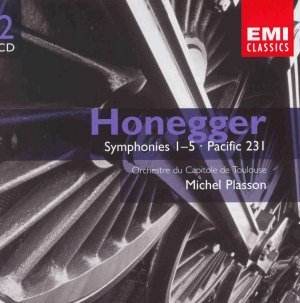The music of the First
Symphony written on a Koussevitsky
commission in the wake of the Pacific
231 coup is sanguine even anarchic
music, rife with soloistic lines for
woodwind and brass. It is closer to
Stravinsky, Markevitch and Roussel than
it is to romantically-inclined contemporaries
although there is considerable humanity
there; something you cannot always say
of Markevitch or Roussel. Malcolm Macdonald
in his notes points out that symphonies
2-4 form a sort of war trilogy. The
Second is for strings alone and
is determinedly serious, written during
the German occupation of Paris. As with
all five symphonies this is in three
movements the last of which is an often
ruthless Vivace which reminded
me of Blissís Music for Strings.
The notes and the workís title proclaim
that this is for strings and trumpet.
In fact this version is recorded without.
I think you will miss that consolatory
grace which is as structurally important
to the emotional payoff as the painfully
beautiful theme that drives the long
finale of the Pettersson Seventh Symphony.
The Liturgique was premiered
in Zurich as was its predecessor. The
clarity of the recording and its impact
are stunning - given the charcoal colour
range this is important. In another
context you might say that this has
a Dickensian redolence: ĎHard Timesí,
perhaps. The cruelty of some heartless
machine age hangs heavily over this
music especially in the first part of
the finale. At 6.40 balm and tears are
released and wounds heal. Honegger has
written some truly tender music to end
this piece. That softer emotion is continued
into the peaceful Fourth Symphony
which serenely evokes the delights
of Basle. This is dreamily done by Plasson
who manages to balance the reflective
radiance of the music with the need
to avoid stagnation. A Britten-like
delicacy - especially in the string
writing - is to be found in the angular
finale which here is not quite as merry
as the note-writer suggests. A heart
attack shortly after the premiere of
the Fourth left Honegger an invalid
for his remaining eight years. In a
commission that brought his symphonies
full circle the Fifth, like the
First, was a Koussevitsky commission.
The title refers to the pianissimo note
D on timpani and basses. This is heard
pizzicato at the end of each movement.
The Symphony is a severe and troubled
work with precious little of the tender
balm so beautifully on show at the end
of the Liturgique. The technically
adroit recording quality greatly aids
Pacific 231 the piece
by which most of us know Honegger. This
has more to do with Mossolovís Iron
Foundry than with Coronation
Scot. Steely magnificence is the
order of the day. There is none of the
gamin humour to be found in Villa-Lobosís
Little Train of the Caipira.
The standard UK price
is £8.50 but you can get these Geminis
from Crotchet or Amazon at £7.99 a piece;
less than four pounds a disc. EMI strike
back at Apex and Regis. In the reissue
stakes this low price series should
be watched carefully.
Honeggerís symphonies
are compactly presented in a single
width case. Good performances although
I am not convinced that an even more
searing effect could not have been achieved.
You may care to compare the Dutoit performances
on Erato-Ultima and the 1960s Baudo
recordings on Supraphon.
Rob Barnett
